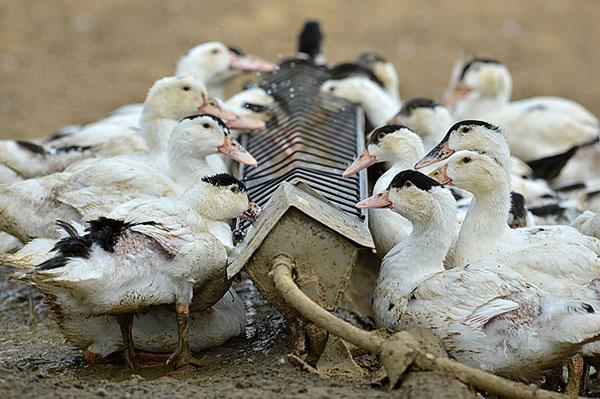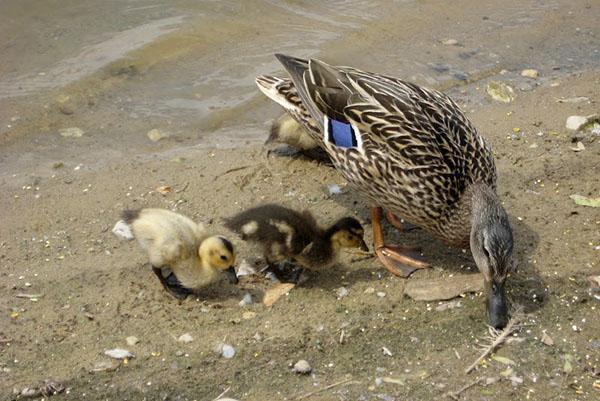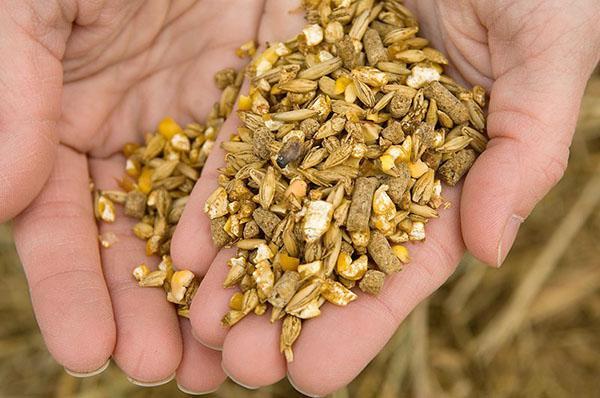How to feed ducks: features of making a diet at home
 Among poultry, ducks are considered unpretentious and very independent pets, but it is impossible to achieve good productivity only with food obtained on the run. How to feed the ducks so that they show their best sides as quickly as possible, grow healthy and hardy?
Among poultry, ducks are considered unpretentious and very independent pets, but it is impossible to achieve good productivity only with food obtained on the run. How to feed the ducks so that they show their best sides as quickly as possible, grow healthy and hardy?
In nature, waterfowl consume succulent plant food, do not disdain insects, small fish, roots and cereals. The menu must include crushed shells, sand and pebbles. The diet of ducks at home should be just as varied. At the same time, the poultry farmer should take into account that the purpose of growing is to fatten well-fed livestock, achieve high egg production and obtain viable strong ducklings. Therefore, feeding the ducks in the conditions of the farm is plentiful, balanced in nutritional and energy value and more satisfying.
How to feed a domestic duck: cereals

- a lot of carbohydrates, which provide the bird with sufficient energy;
- proteins, which are the basis of the structure of muscle mass;
- cellulose;
- vitamins and mineral salts.
On forage with a predominance of cereals, ducks quickly gain weight and grow, and the correctly selected grain is easily digested and is liked by both young birds and adult birds.
Of all the variety of cereals, experienced poultry farmers prefer corn, which contains a little fiber, but easily replenishes the energy needs of ducks and contains carotene. The composition of compound feed for ducks can include up to 50% of the grains of this crop. If mixtures are prepared for young stock, the corn content is reduced by about 10%.
 Wheat, the second most popular and valuable crop, has more protein and a lot of B vitamins. When feeding ducks, the poultry farmer can take about a third of the food eaten by birds to this cereal.
Wheat, the second most popular and valuable crop, has more protein and a lot of B vitamins. When feeding ducks, the poultry farmer can take about a third of the food eaten by birds to this cereal.
Not only crushed wheat grain is used, but also coarse flour. It is better to add it to wet mash.
Barley is no less valuable than wheat, but the shell of the grains of this crop is extremely poorly digested and can cause unhealthy ducks. Therefore, ducklings are advised to give cereals crushed and peeled from a coarse shell, and it is useful to include sprouted grains in the diet of older ducks, the usefulness and nutritional value of which is much higher.
Oats can be added to duck feed. This culture is the leader in the content of fat in the grain, it contains a lot of vitamins, amino acids and proteins. But in order for such food to be useful, the poultry farmer needs to take care of cleaning the grain from practically indigestible shells.
Legumes are famous for their high protein content, which, for example, in peas about 20%. However, ducks are relatively indifferent to such food, therefore, it is introduced in the menu in crushed form and no more than a tenth of the total portion volume.
How to feed ducks at home? What, besides grain, will benefit the livestock?
We must not forget about meal and cake. They contain a lot of oil remaining after processing of seeds, potassium and phosphorus, as well as protein necessary for the growth of ducks.on poultry menus, these products from a wide variety of oilseeds can account for up to 10% of the cereals supplied.
From three weeks of age, ducklings can be fed carbohydrate-rich beet pulp. Bran is cheap and useful. This product is high in protein, but since the bran base is coarse fiber, it's important not to overdo it. An excess of it in the diet of ducks leads to digestive problems.
From 10 days of age, yeast is added to the feed for ducklings. They, like dried bread and then soaked in water, are an excellent source of B vitamins.
Succulent food for ducks
 Green duck food is always a favorite food. In nature and on summer walks, the bird especially eagerly eats juicy aquatic vegetation containing a lot of trace elements, proteins and vitamins. How to feed ducks if they do not have access to a natural body of water?
Green duck food is always a favorite food. In nature and on summer walks, the bird especially eagerly eats juicy aquatic vegetation containing a lot of trace elements, proteins and vitamins. How to feed ducks if they do not have access to a natural body of water?
The birds are offered pre-harvested duckweed and other crops, and they also do not forget about the benefits of herbs, which are always available in almost every area. It:
- nettle, which must be doused with boiling water before feeding domestic ducks;
- tops of peas, alfalfa and other forage legumes;
- clover.
Ducks are happy to eat juicy vegetables, such as those rich in carotene pumpkin and carrots, as well as almost all types of cabbage, lettuce and green onions.
Melons and root crops are necessarily chopped when feeding ducks. If the menu includes potatoes and sugar beets, then they are pre-boiled.
Animal feed for ducks
Feeding ducks at home is impossible without adding animal products. It is an excellent source of protein, calcium and other elements, essential for the proper development of poultry. The inclusion of fish and meat and bone meal in the diet is well accepted by waterfowl. You can add minced meat from frozen fish, chopped and thermally processed meat waste to the menu.
From the very first days of life, ducklings are given low-fat cottage cheese, then other fermented milk products are included in the diet. They provide the chicks with calcium and easily digestible protein.
Mineral supplements for ducks
 Calcium is essential for all types of poultry. It is not only a building material for the skeletal system, but also an element consumed in huge quantities by layers to form a strong shell. How to feed a domestic duck to replenish these expenses?
Calcium is essential for all types of poultry. It is not only a building material for the skeletal system, but also an element consumed in huge quantities by layers to form a strong shell. How to feed a domestic duck to replenish these expenses?
The bird is offered:
- crushed eggshell;
- a shell, carefully crushed and added to the mash;
- a piece of chalk;
- bone meal.
If salted feed is not included in the diet of ducks, then table salt, which is a source of sodium and chlorine, is given separately.
In addition, coarse, washed sand or fine gravel is always offered to poultry as an irreplaceable mineral supplement. These seemingly inedible components of the menu are extremely important for ducks, as they provide rapid digestion of roughage and grains.
Minerals are not mixed with compound feed for ducks, but are poured into separate containers, the filling of which must be constantly monitored.
Feeding domestic ducks depending on the season
From mid-spring, throughout the summer and most of the fall, feeding the domestic duck is as varied as possible. If the bird has access to a reservoir, then it independently obtains up to the required daily amount of feed.
However, this does not relieve the poultry farmer of responsibility. Supplementation is still necessary. How to feed ducks returning home from grazing?
 The ducks kept in the pens are fed four times a day. Two feedings are wet food combined with greens, and two more meals are grain mixes and compound feed for duck. A bird that obtains part of its food on its own must receive additional cereals and protein components of the diet.
The ducks kept in the pens are fed four times a day. Two feedings are wet food combined with greens, and two more meals are grain mixes and compound feed for duck. A bird that obtains part of its food on its own must receive additional cereals and protein components of the diet.
The peculiarity of summer feeding of ducks is strict monitoring of food rationing.Portions are calculated so that after one approach the feeders are emptied, otherwise sour residues will cause serious infections among the livestock.
 With the onset of the cold season, the list of "dishes" in the menu of domestic ducks is significantly reduced. What do ducks eat at this difficult time? So that the bird does not experience a lack of vitamins and mineral salts, it is offered silage from herbs and chopped vegetables, as well as grass flour and steamed hay. The diet of ducks must include animal feed, boiled potatoes and nutritious grain mixtures.
With the onset of the cold season, the list of "dishes" in the menu of domestic ducks is significantly reduced. What do ducks eat at this difficult time? So that the bird does not experience a lack of vitamins and mineral salts, it is offered silage from herbs and chopped vegetables, as well as grass flour and steamed hay. The diet of ducks must include animal feed, boiled potatoes and nutritious grain mixtures.
In cold weather, feeding domestic ducks is calculated so that the food covers the body's energy costs not only for growth, but also for rewarming.
Formulation of a ration for laying hens and when feeding ducks
Domestic ducks of meat direction are early maturing and for the highest productivity when fattening they require a special diet almost from birth.

The faster the bird gains slaughter weight, the more tender the meat will be. Therefore, the menu for fattening ducks should be as balanced and varied as possible, including proteins for building muscle mass, as well as carbohydrates, minerals and vitamins.
 Layers need their own "diet" to which birds are transferred 20 days before the start of laying. In the diet of this category, birds are introduced more concentrates and protein-rich feed. Particular attention is paid to replenishing the body with calcium, providing the growing moisture needs of the duck, and reducing the proportion of greens, rough and juicy foods.
Layers need their own "diet" to which birds are transferred 20 days before the start of laying. In the diet of this category, birds are introduced more concentrates and protein-rich feed. Particular attention is paid to replenishing the body with calcium, providing the growing moisture needs of the duck, and reducing the proportion of greens, rough and juicy foods.
The menu for laying hens includes sprouted grains and yeast containing many amino acids and active substances.